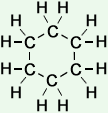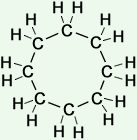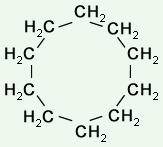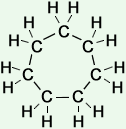
Introducing Cycloalkanes
Definition of Cycloalkanes:
Cycloalkanes are a particular type (or category) of alkanes.
Reminder: Alkanes are hydrocarbon chemical compounds, meaning that they consist only of the elements carbon (C) and hydrogen (H). Alkanes are saturated hydrocarbons, meaning that they contain only single (not double or triple) covalent bonds.
Each carbon atom forms 4 bonds (either C-H or C-C bonds).
Each hydrogen atom is connected to a single carbon atom, by a H-C bond.
Cycloalkanes are distinguished from other types of alkanes i.e. linear alkanes and branched alkanes by their structure.
That is, cycloalkanes include a part consisting of at least three carbon atoms linked together by single covalent bonds in the form of a ring, or loop. See diagrams below.
General Formula:
Simple cycloalkanes, that is those without any additional branches attached (see later), have the general formula:
CnH2n
where n represents the number of carbon atoms in the cyclalkane (must be a whole number greater than 2).
Have you seen this general formula anywhere else? It is also the general formula of linear alkenes. This means that cycloalkanes are isomers of the corresponding linear alkene, and vice-versa, for molecules containing 3 or more carbon atoms.
Names and Structures of simple Cycloalkanes
The first eight members of the homologous series of simple cycloalkanes are shown below.
Notice that the full displayed structures of cycloalkanes become increasingly awkward to draw as the size of the moleclues increase. You may therefore be tempted to group parts of a molecule together in order to represent it more easily, quickly and clearly. There are standard ways to do this and it is important to follow the conventions so that your drawings are understood - see the examples in the table.
Name |
Full Displayed Structure |
More concise structure |
Skeletal (Displayed) Structure |
|
3 |
cyclopropane |
 |
||
4 |
cyclobutane |
 |
||
5 |
cyclopentane |
 |
||
6 |
cyclohexane |
 |
||
7 |
cycloheptane |
 |
||
8 |
cyclooctane |
 |
||
9 |
cyclononane |
 |
||
10 |
cyclodecane |
 |
 |
 |
Cyclopropane
Molecular Formula: C3H6
Full Displayed Structure: More concise Structure:
More concise Structure: Skeletal (Displayed) Structure:
Skeletal (Displayed) Structure:
(regular triangle, 3-sided regular polygon)Alternative names:- trimethylene
- trimethylene (cyclic)
Cyclobutane
Molecular Formula: C4H8
Full Displayed Structure: More concise Structure:
More concise Structure: Skeletal (Displayed) Structure:
Skeletal (Displayed) Structure:
(regular square, 4-sided regular polygon)Alternative names:- tetramethylene
Cyclopentpane
Molecular Formula: C5H10
Full Displayed Structure: More concise Structure:
More concise Structure: Skeletal (Displayed) Structure:
Skeletal (Displayed) Structure:
(regular pentagon, 5-sided regular polygon)Alternative names:- pentamethylene
Cyclohexane
Molecular Formula: C6H12
Full Displayed Structure: More concise Structure:
More concise Structure: Skeletal (Displayed) Structure:
Skeletal (Displayed) Structure:
(regular hexagon, 6-sided regular polygon)Alternative names:- hexamethylene
- hexanaphthene
- hexahydrobenzene
- benzenehexahydride
- polycyclohexane
- hexahydro-benzene
Cycloheptane
Molecular Formula: C7H14
Full Displayed Structure: More concise Structure:
More concise Structure: Skeletal (Displayed) Structure:
Skeletal (Displayed) Structure:
(regular heptagon, 7-sided regular polygon)Alternative names:- heptamethylene
- suberane
Cyclooctane
Molecular Formula: C8H16
Full Displayed Structure: More concise Structure:
More concise Structure: Skeletal (Displayed) Structure:
Skeletal (Displayed) Structure:
(regular octagon, 8-sided regular polygon)Alternative names:- octamethylene
- cyclooctan
Cyclononane
Molecular Formula: C9H18
Full Displayed Structure: More concise Structure:
More concise Structure: Skeletal (Displayed) Structure:
Skeletal (Displayed) Structure:
(regular enneagon, 9-sided regular polygon)Cyclodecane
Molecular Formula: C10H20
Full Displayed Structure: More concise Structure:
More concise Structure: Skeletal (Displayed) Structure:
Skeletal (Displayed) Structure:
More about Drawing Molecules of Cycloalkanes:
Representing molecular structures clearly:
Taking the example of cyclohexane, consider the advantages and disadvantages of some possible ways of representing the structure of cyclohexane:
Diagram of Molecular Structure |
Advantages |
Disadvantages |
|
1. |
 |
|
|
2. |
 |
|
|
3. |
|
|
|
Possibility (1)  |
|
Advantages:
|
Disadvantages:
|
Possibility (2)  |
|
Advantages:
|
Disadvantages:
|
Possibility (3)  (regular hexagon; 6-sided regular polygon) |
|
Advantages:
|
Disadvantages:
|
Which type of molecular structure should I draw ?
The most appropriate representation to use depends on the context and reason for drawing the molecular structure.
If you are drawing structures of cycloalkanes as part of your studies, coursework or in an exam you should choose which type of structure to draw based on:
- Specific instructions given by your teacher or lecturer or in the question you have been asked.
- Which type of structures have been taught and used by teachers or lecturers during this part of your course.
- Which type of structures / diagrams appear elsewhere in the printed or electronic documents you are working from, e.g. textbooks or exam paper.
- The number of marks allocated for the question (or part of the question), if you are given that information.
- The overall complexity of the molecule; the more complicated the molecule, the more difficult it is to represent it clearly using by a full displayed structure that includes every single covalent bond.
Some of the chemistry pages on this website indicate only full displayed structures, especially when presenting introductory-level information about compounds / molecules and types of organic compounds / molecules. Other pages show skeletal molecular structures, especially when describing more complicated molecules and / or discussing and explaining their properties in terms of specific functional groups, which are often indicated more clearly by use of diagrams of skeletal structures.
Shapes of simple Cycloalkanes:
The above diagrams of the molecular structures of cycloalkanes may give the impression that these molecules have shapes similar to flat regular polygons. That is not true. It is always important to remember that molecular structures are drawn to represent the atoms present and the bonds between them as clearly as possible (often, as in this case) in two-dimensions. In reality, these molecules are three-dimensional structures.
More Complicated Cycloalkanes
The cycloalkanes listed and drawn in the main table (above) are described as 'simple' cycloalkanes because they do not include any additional branches or functional groups. When studying organic chemistry it is generally easier to begin by learning about different types of compounds by considering simple examples first. However, many important compounds and their molecules include parts of more than one type and consist of a combination of linear chains of carbon atoms, rings of carbon atoms (as in the case of cycloalkanes), and long or short branches extending from linear carbon chain and/or carbon rings.
We plan to add further pages about naming (complex) cycloalkanes, examples of cycloalkanes and reactions of cycloalkanes.




















